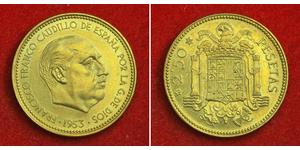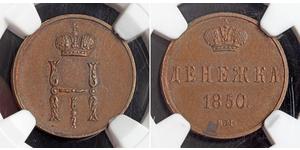100 Peseta (Venduta per $8.0)
1966, Spain, Francisco Franco. Silver 100 Pesetas Coins. Struck during 1968!
Reference: KM-797. Denomination: 100 Pesetas Condition: Minimal deposits and minute nicks, otherwise a nice lustre UNCirculated coin! Mint Year: dually dated, once the date of the issue (1966) and once the actual date of striking (1968) within the stars which flank the date in obverse! Material: Silver (.800) Weight: 19.08gm Diameter: 34mm
Obverse: Head of Francisco Franco right. Legend: FRANSISCO FRANCO CAUDILLO DE ESPANA POR LA G. DE DIOS (19) 1966 (68) Reverse: Assorted arms of Spain within traditional cross-shaped tressure. Crown above, crosses below and at sides. Legend: 100 PTAS
Francisco Franco y Bahamonde (4 December 1892 – 20 November 1975) was a Spanish military leader who ruled as the dictator of Spain from 1939 until his death. He came to power during the Spanish Civil War while serving as the Generalísimo of the Nationalist faction.
Franco came from a military background. He became a highly decorated soldier and won rapid promotions in the army. He rose to prominence during the 1920s as a commander in the Spanish Legion and became the youngest general in Europe. He was then appointed in charge of Academia General Militar, Spain's main military academy at Zaragoza. However, with the fall of the Spanish monarchy and the establishment of the Second Republic in 1931, Franco, as a conservative and monarchist officer, was marginalized from power by the Republican government. Franco managed to return to prominence with the electoral victory of the conservatives in 1933. He was appointed Chief of Staff of the military and suppressed the anarchist uprising of 1934. In 1936, Franco and a group of Spanish military leaders conspired to overthrow the Popular Front–led Republican government. The rebellion was only half successful and evolved into a civil war, during which Franco emerged as the leader of the Nationalists. He was able to secure the support of Italy and Germany while integrating the many heterogeneous rebel factions into the Movimiento Nacional. After winning the civil war, Franco had the Spanish Parliament dissolved. He then established a dictatorship and was de facto regent of the nominally restored Kingdom of Spain. His official posts were that of Head of State and Head of Government as the Caudillo (The Leader) and Prime Minister respectively.
Franco went on to rule Spain for nearly forty years. He was able to hold on to power by playing off the diverse political factions of the state against one another and through his control over the armed forces while firmly repressing enemies. This included the systematic suppression of dissident views through censorship and coercion, the imprisonment of ideological enemies in concentration camps, the implementation of forced labour in prisons, and the use of the death penalty and heavy prison sentences as deterrents for the opponents of the regime. Pragmatism for the purpose of maintaining stability characterised Franco's economic and foreign policies. Despite his pro-Axis leanings during World War II, Franco orchestrated a rapprochement with the Western democracies, concluding economic and defense agreements with the United States during the Cold War against Communism. Franco initially pursued autarkic development strategies. Amidst economic difficulties in the late 1950s, a cabinet reshuffle brought into the government the Opus Dei technocrats who, despite Franco's distrust of liberalism, convinced the general to steer Spain towards a market economy. The reforms produced the Spanish Miracle, a long run of record growth that has been described as "the time of the greatest sustained economic development and general improvement in living standards in all of Spanish history." Socially, Franco was a conservative and championed the cause of Catholicism. The consistent points of his policies, termed as Francoism, had at its core authoritarianism, nationalism, integralism, conservatism, and a frontal rejection of anticlericalism and leftist politics. Others have described him as a reactionary, who led the counter-revolutionary movement in Spain.
Franco's health declined during the 1960s. In 1969, he designated Prince Juan Carlos, grandson of Spain's former king, Alfonso XIII, as his official successor. In 1973, Franco relinquished his position as premier to Luis Carrero Blanco but continued to be head of state. He finally died at the age of 82 in 1975. After Franco's death, Juan Carlos became king and Spain began its transition to democracy. The transitional government forged the Pact of Forgetting; a political agreement between the right and the left to avoid having to deal with the legacy of Francoism in favour of national reconciliation. In 2007, the status quo was challenged by the socialist government, which sought to condemn the Francoist regime through the Historical Memory Law. The conservative opposition voted against the passage of the law. However, the government was able to pass the bill; among other measures, the law rejected the legitimacy of the Francoist regime and prohibited the use of Francoist symbols. After the conservatives came to power in 2011, the government closed the offices pertaining to the law, and also withdrew funding. Franco has been criticized in the rest of Europe, where the European Parliament unanimously adopted a resolution in 2006 that "firmly" condemned the "multiple and serious violations" of human rights committed under the Francoist regime. His mausoleum in the Valley of the Fallen is subject to much controversy in Spain; there have been various attempts to remove and relocate his remains.
Only 1$ shipping for each additional item purchased!

|
Postato da:
anonymous 2020-12-06 |
|
||
|
||
|
||
|
||
|
||
1 Denga Russia Rame Nicola I (1796-1855)
il gruppo ha 5 monete / 4 prezzi
⇑
50 Peso Messico (1867 - )
il gruppo ha 7 monete / 6 prezzi
⇑

-600-300-azenjuCheiYAAAF24Zp6mzak.jpg)

-300-150-Fz7BwcI0ueYAAAErqzDyN.1j.jpg)
 Deutsch
Deutsch Русский
Русский Українська
Українська English
English Italiano
Italiano Français
Français Español
Español 汉语
汉语







-300-150-SasKb0OM8JcAAAFDTuo8X9pc.jpg)






